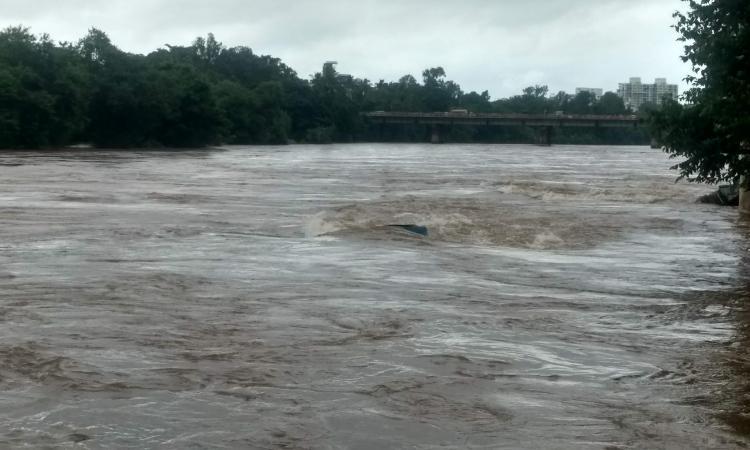
India is one of the most flood-affected country following China and floods account for 53 percent of the disasters followed by cyclones (21 percent), landslides (10 percent), cold waves (6.4 percent), earthquakes (4.2 percent), and droughts (2 percent).
Floods also lead to the highest (68 percent) of economic losses in the country and are the second most lethal disasters following earthquakes, cyclones, heat-waves, cold waves, landslides and droughts informs this paper titled 'Role of income and government responsiveness in reducing the death toll from foods in Indian states' published in Nature Scientific Reports.
India has lost around 0.46 percent of gross domestic product (GDP) to floods with crop damages at 0.18 percent of GDP and 0.21 percent to damage to public utilities. Six percent of the rural population is affected due to foods annually in the country. Floods also increase the financial burden on the government because of the need to increase spending on flood protection measures and creating flood-resilient infrastructure.
A number of studies have shown that countries with higher per capita income experience lower disaster deaths than developing countries. There have been no studies in the Indian context that have looked at the relationship between flood fatalities and per capita income. This paper examines the impact of income and government responsiveness on flood related deaths in Indian states.
The study uses state-wise panel data on annual deaths and population affected due to foods in 19 Indian states from 1980 to 2011 and attempts to answer the following questions:
- How does per capita income affect flood fatalities in Indian states?
- When flood disasters occur, how many fewer deaths are caused in high-income (rich) Indian states than in low-income (poor) states.
- Does government responsiveness (proxied by natural calamity expenditure) reduce the flood impact (measured by deaths and population affected due to floods)?
The study defines government responsiveness as how the government responds during and in post-flooding situations and provides necessary services to citizens to minimise the flooding impact. This also includes ex-ante measures such as building up food-resilient infrastructure and devising suitable food control measures to alleviate food risk.
The study finds that:
There is a nonlinear relationship between per capita income and flood impact
There is a non-linear (inverted U-shaped) relationship between per capita income and flood impact (measured via flood fatalities, the population affected, and flood damages) in high-income states. Thus, in the initial phases, deaths from floods increase with income but then start decreasing as income crosses the turning point.
This inverted U-shaped relationship between per capita income and flood related deaths is weak for low-income states. This is because poor states are not able to generate adequate revenues and hence find it difficult to mitigate the effects of disasters. In contrast, states with higher per capita income are relatively more capable of investing in flood-precautionary measures such as rehabilitation, evacuation, relief distribution, and disaster warning systems.
In a developing economy like India, societies spend more income on basic needs in the initial phase, and less money is spent on safety and disaster preparedness measures. Over the period, when society’s per capita income increases, the demand for safety rises because income provides insurance against natural disasters.
Government expenditure on flood risk mitigation is inadequate
Around 53,200 people have been killed in all states due to floods when natural calamity expenditure as a percentage of GSDP is lower than 0.87 percent (turning point). Nearly 3536 people have died when the turning point of NCE as a percentage of GSDP reaches above 0.87 percent. Thus higher government spending to protect citizens against natural calamities is essential to reduce flood mortality.
While greater government spending can help mitigate the effects of floods, low income states with relatively lower ability to spend on disasters experience a U-shaped relationship between flood fatalities and government responsiveness. The government responsiveness provides protection but at a diminishing rate. This implies that states with lower income and inadequate government responsiveness are more likely to suffer greater flood related deaths than developed states.
Disaster adaptation measures such as financial development, forest cover, and food control expenditure are not sufficient to alleviate flood fatalities. The state election and existing political alignment between State and the Centre help to minimise food fatalities.
Thus, states with higher per capita income can spend more on flood control and mitigation measures and constructing flood-resilient infrastructure to minimise flood impact. However, the current level of government responsiveness is not adequate to mitigate food fatalities and damages in both high-income and low-income states. Low-income states need special government attention to reduce the adverse effects of floods.
The paper ends by arguing that the government must spend more on rehabilitation, relief distribution, evacuation, and flood warning measures to minimise future flood risks in the country. Other measures such as long-term flood management policy, increased government spending on flood control and irrigation, and allowing forest cover to grow can considerably reduce the impacts of floods in the country.